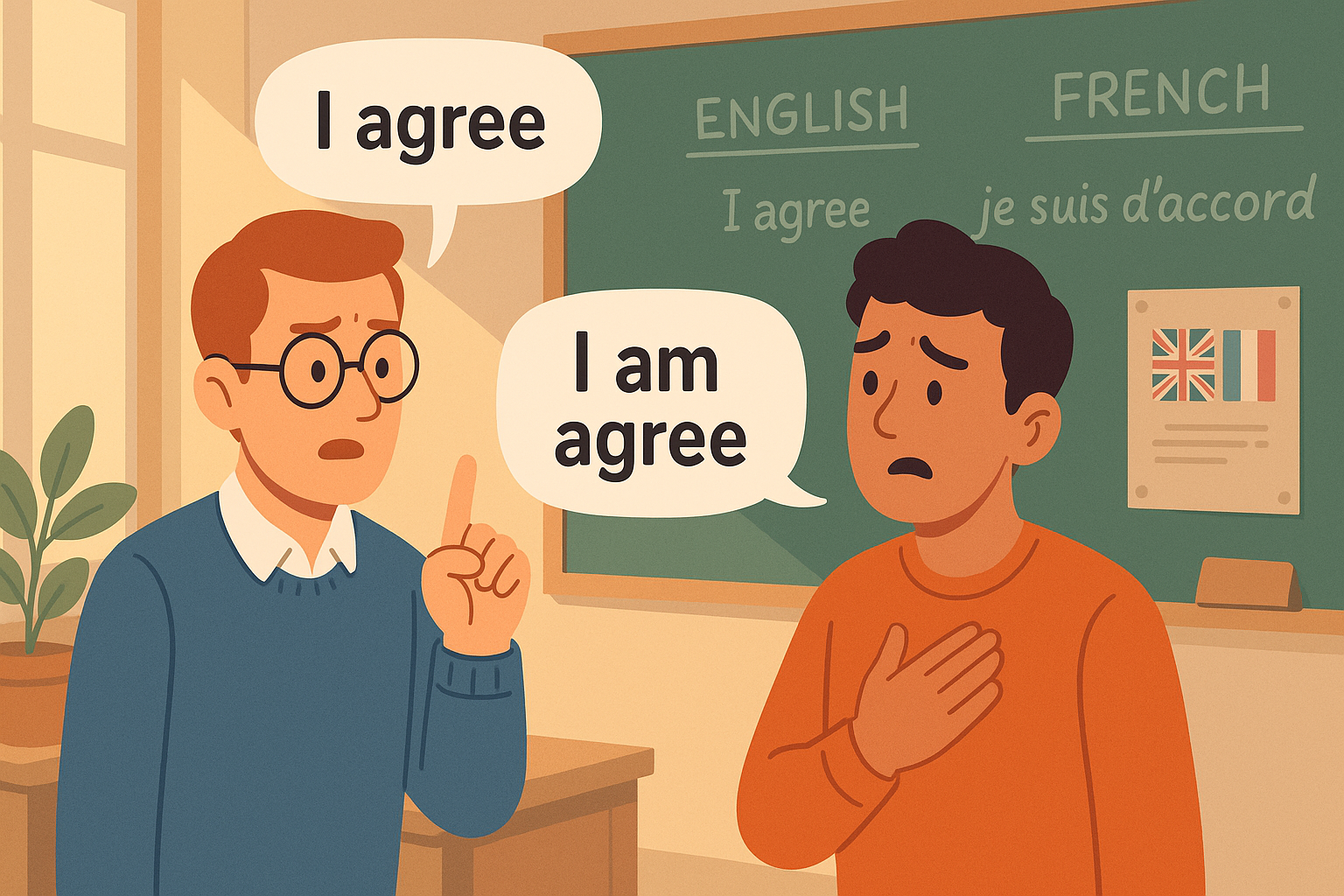Why French speakers say “I am agree” instead of “I agree” — grammar explanation (A2–B2)
French speakers learning English persistently make the mistake “I am agree” instead of “I agree” despite repeated corrections. This error stems from direct grammatical interference from French “je suis d’accord,” revealing how native language structures unconsciously influence second language production. Understanding why this mistake occurs helps both French speakers learning English and English speakers understanding French grammar patterns.

The root cause — French “être” vs English “to be”
The error “I am agree” results from linguistic interference—when native language grammar patterns unconsciously transfer to a second language. French speakers learning English automatically translate “je suis d’accord” (I am in agreement) word-for-word into English, producing “I am agree.” This direct translation feels natural because it follows French grammatical logic, creating a persistent fossilized error that resists correction even at advanced English proficiency levels.
🇫🇷 FR (correct) — Je suis d’accord avec toi. /ʒə sɥi dakɔʁ avɛk twa/
Literal translation: I am of agreement with you.
Structure: Subject + être + prepositional phrase
🇺🇸 EN (WRONG) — I am agree with you. ❌
🇺🇸 EN (CORRECT) — I agree with you. ✅
Structure: Subject + verb (no “to be”)
The fundamental difference lies in how French and English express agreement. French uses the verb “être” (to be) plus a prepositional phrase “d’accord” (of agreement). English uses “agree” as a main verb directly, requiring no auxiliary “to be.” French speakers applying French grammar rules to English unconsciously insert “am” because “je suis” requires it, not realizing English “agree” functions completely differently as a standalone verb.
Why this mistake persists despite correction
Deep grammatical pattern interference
This error proves particularly resistant to correction because it involves fundamental structural differences between how the languages construct meaning. Unlike simple vocabulary mistakes that correction easily fixes, grammatical interference requires rewiring deeply internalized language production patterns. French speakers know intellectually that “I agree” is correct, but in spontaneous speech or writing, the French pattern automatically activates, producing “I am agree” before conscious monitoring can intervene.
The “être” reflex in French grammar
French uses “être” (to be) far more extensively than English uses “to be” for constructing various grammatical structures. French speakers develop a strong reflex to use “être” as grammatical glue connecting subjects to states, conditions, and descriptions. This over-reliance on “être” transfers to English, where French speakers unconsciously insert “to be” in contexts where English doesn’t require it.
Common “to be” interference errors from French
- ❌ “I am agree” → ✅ “I agree” (je suis d’accord)
- ❌ “I am disagree” → ✅ “I disagree” (je ne suis pas d’accord)
- ❌ “I am bored” (when meaning “I find this boring”) → ✅ “I’m boring / This bores me” (confusion with “je m’ennuie”)
- ❌ “I am 25 years” → ✅ “I am 25 years old” (j’ai 25 ans uses “avoir” but English needs “old”)
- ❌ “I am cold/hot” (weather) → ✅ “It is cold/hot” (j’ai froid/chaud uses “avoir” not “être”)
Lack of contrastive instruction
Traditional English instruction for French speakers rarely explicitly highlights this grammatical difference. Teachers correct “I am agree” to “I agree” without explaining the underlying structural difference between French prepositional phrases with “être” and English standalone verbs. Without understanding why the error occurs, French speakers cannot consciously monitor and prevent it, allowing the mistake to fossilize permanently.
Similar French-English interference patterns
Missing articles — French definiteness vs English usage
French pattern: Uses definite articles for generic statements
❌ “I love the chocolate” (J’aime le chocolat)
✅ “I love chocolate” (generic, no article needed)
❌ “The life is beautiful” (La vie est belle)
✅ “Life is beautiful”
Why it happens: French requires articles before nouns in generalizations; English omits them for uncountable/abstract nouns in generic statements.
Age expression — “avoir” vs “to be”
French pattern: Uses “avoir” (to have) for age
❌ “I have 30 years” (J’ai 30 ans)
✅ “I am 30 years old”
Why it happens: French speakers directly translate “j’ai 30 ans” (I have 30 years) instead of using English “to be” for age.
Weather and physical sensations — “avoir” confusion
French pattern: Uses “avoir” for physical sensations that English expresses with “to be”
❌ “I have cold/hot/hungry/thirsty” (J’ai froid/chaud/faim/soif)
✅ “I am cold/hot/hungry/thirsty”
BUT for weather:
❌ “I am hot” (when referring to weather, not personal sensation)
✅ “It is hot” (Il fait chaud)
Missing continuous form — simple vs progressive aspect
French pattern: Uses simple present for ongoing actions
❌ “I eat” (when currently eating) (Je mange)
✅ “I am eating”
❌ “What do you do?” (when asking about current activity)
✅ “What are you doing?”
Why it happens: French simple present covers both habitual and ongoing actions; English distinguishes through simple vs continuous aspect.
The reverse error — English speakers learning French
Interestingly, English speakers learning French make mirror-image errors, demonstrating how grammatical interference operates bidirectionally. Understanding these reverse mistakes helps French speakers recognize the structural differences more clearly while showing English speakers the challenges French learners face.
Common English speaker errors in French
- ❌ “J’agree avec toi” → ✅ “Je suis d’accord avec toi” (trying to use “agree” as French verb)
- ❌ “Je suis 25 ans” → ✅ “J’ai 25 ans” (using “être” instead of “avoir” for age)
- ❌ “Je suis chaud/froid” (physical sensation) → ✅ “J’ai chaud/froid”
- ❌ “J’aime chocolat” → ✅ “J’aime le chocolat” (missing required article)
- ❌ “Vie est belle” → ✅ “La vie est belle” (missing required article)
These reverse errors reveal that both language groups struggle with the same structural differences from opposite directions. French speakers over-use “to be,” while English speakers under-use “être” and “avoir” in contexts where French requires them. This symmetry demonstrates that the difficulty lies not in one language being “harder” but in structural mismatches between grammatical systems.
How to overcome “I am agree” and similar errors
Strategy 1: Learn verb categories explicitly
Understand that “agree,” “disagree,” “think,” “believe,” “know,” “remember” function as main verbs in English, never requiring “to be” as auxiliary. Create a mental list of these “no to-be” verbs to activate conscious monitoring when using them.
💡 Memory technique: When tempted to say “I am agree,” pause and think “agree = verb, not adjective.” Verbs don’t need “to be” in simple present; adjectives do. “I am happy” (adjective). “I agree” (verb).
Strategy 2: Practice contrastive pairs
Explicitly compare French and English structures to internalize differences:
🇫🇷 FR — Je suis d’accord
Structure: être + prepositional phrase
🇺🇸 EN — I agree
Structure: main verb (no auxiliary)
🇫🇷 FR — J’ai 30 ans
Structure: avoir + age
🇺🇸 EN — I am 30 years old
Structure: to be + age + “old”
Strategy 3: Use correction as learning opportunity
When corrected for saying “I am agree,” don’t just accept the correction passively. Ask yourself: “Why is this wrong? What’s the French interference pattern? What’s the correct English structure?” This metacognitive reflection builds awareness preventing future occurrences more effectively than simple correction alone.
Strategy 4: Immerse in English input
Extensive reading and listening to authentic English helps internalize correct patterns through exposure. Notice how native speakers express agreement naturally: “I agree,” “I think so too,” “Exactly,” “That’s right.” This input gradually overwrites the French interference pattern with authentic English alternatives.
Strategy 5: Slow down in production
Fossilized errors occur most frequently in rapid speech when conscious monitoring relaxes. Deliberately slow your English production speed slightly, allowing time for conscious grammatical checking before speaking. This temporary slowdown creates space for catching and correcting interference errors before they vocalize.
Why understanding interference matters for all learners
Grammatical interference affects all language learners regardless of native language or target language. Every language pair exhibits systematic interference patterns where structures from Language A unconsciously transfer to Language B inappropriately. Understanding this phenomenon helps learners:
- Recognize that persistent errors aren’t personal failures but predictable linguistic interference
- Identify systematic error patterns enabling targeted correction strategies
- Develop metacognitive awareness of when interference likely occurs
- Apply conscious monitoring specifically to high-risk interference structures
- Accept that overcoming deep grammatical interference requires time and deliberate practice beyond simple correction
For English speakers learning French, understanding how French speakers struggle with “I am agree” in English illuminates why you struggle with “j’ai 25 ans” in French—both stem from the same interference mechanism operating in reverse. This mutual understanding builds empathy for the challenges of language learning while providing insight into effective correction strategies.
The broader lesson — languages structure reality differently
The “I am agree” error reveals a profound linguistic truth: languages don’t simply attach different labels to universal concepts but structure meaning itself differently. French conceptualizes agreement as a state of being (“être d’accord” – to be in agreement) while English treats it as an action (“agree” – perform agreement). Neither approach is more logical or natural—they’re simply different conventional systems for organizing human experience linguistically.
These structural differences extend beyond grammar into conceptual organization. French uses “avoir” (to have) for age, hunger, and temperature sensations—conceptualizing them as possessions. English uses “to be” for these concepts—treating them as states. Neither language’s approach is objectively correct; they represent different cultural-linguistic traditions for carving up reality into expressible categories.
Understanding these deep structural differences develops linguistic sophistication beyond vocabulary and grammar rules. It reveals that learning a language means learning a new way of organizing thought and expressing experience, not just translating your native language’s conceptual system into new words. This insight transforms language learning from mechanical translation to genuine bicultural thinking.
Study glossary — grammar terminology
| EN | FR | Definition |
|---|---|---|
| Interference | Interférence | Native language patterns affecting second language |
| Transfer | Transfert | Applying L1 rules to L2 (positive or negative) |
| Fossilized error | Erreur fossilisée | Permanent error resistant to correction |
| Auxiliary verb | Verbe auxiliaire | Helping verb (to be, to have, will, etc.) |
| Main verb | Verbe principal | Primary action/state verb in sentence |
| Prepositional phrase | Syntagme prépositionnel | Phrase beginning with preposition |
| Aspect | Aspect | How action unfolds (simple vs continuous) |
| Contrastive analysis | Analyse contrastive | Comparing two language structures |
| Pattern | Schéma / Modèle | Recurring grammatical structure |
| Structure | Structure | Grammatical organization of sentence |
Authoritative references
- Cambridge University Press — research on language interference and transfer.
- British Council Teaching English — resources on common learner errors.
Learn French with Roger, Native French Tutor
Expert instruction with proven teaching methods. Personalized lessons tailored to your goals from A0 to C1.
Weekly Lessons with Roger
Learn with Roger, a native French tutor. Structured curriculum from beginner to advanced.
- Native French speaker from France
- All levels (A0-C1) supported
- Personalized curriculum
- Proven teaching methodology
Trial Lesson with Roger
Experience Roger’s teaching method with a 25-minute trial session. Perfect to get started.
- 25 minutes with Roger
- Level assessment included
- Personalized learning roadmap
- No commitment required
A1 Foundations Guide
Complete beginner’s guide created by Roger. Structured lessons with native pronunciation.
- Step-by-step A1 curriculum
- Audio by native French speaker
- Practice exercises included
- Learn at your own pace
Continue Learning
Check out these related articles

French pharmacy phrases (A1–B1) — symptoms, advice, dosage, and OTC help
French pharmacy phrases help you explain symptoms, ask for over-the-counter help, and confirm dosage and side effects. This A1–B1 guide…

French cinema classics (A1–B1) — learn French through movies
Explore French cinema from the Lumière brothers to modern hits, and learn practical French with friendly A1–B1 lines, IPA, and…

Best way to learn French for English speakers — what actually works (A1–C1)
Discover the most effective methods for English speakers learning French, including proven strategies that leverage your native language advantages, avoid…
👋 Join Our Community
Follow us for daily tips, pronunciation tricks, and free resources
👍 Follow on Facebook